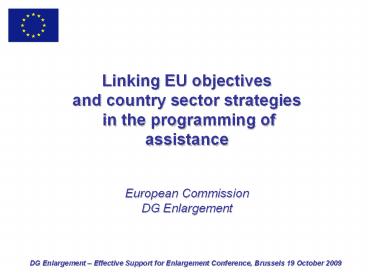DG Enlargement PowerPoint PPT Presentation
1 / 12
Title: DG Enlargement
1
Linking EU objectivesand country sector
strategies in the programming of
assistance European CommissionDG Enlargement
DG Enlargement Effective Support for
Enlargement Conference, Brussels 19 October 2009
2
IPA Programming framework
Enlargement strategy
IPA/EP
SAA/EP
Economic Dialogue
MIPD
Rural development
Economic and Social cohesion
Institution Building
Adoption ofEU policiesand legislation
IPARD progr
SCF/Op. progr
Economic Fiscal Programme
NPAA
National Development PlanCountry strategies
3
Sector Approaches
- Sector approach
- programme based approach for a given sector
- Key features
- Leadership by partner country
- Single comprehensive sector programme and budget
framework - Formalised process of donor coordination and
harmonisation of donor procedures for reporting,
budgeting, financial management and procurement - Efforts to increase the use of local systems for
programme design and implementation, financial
management, monitoring and evaluation (including
through the adoption of DIS in enlargement
countries)
4
Core elements of a sector programme
- Three core elements
- Sector policy and strategy
- Sector budget and its medium-term expenditure
perspective - Sector coordination framework through which the
strategy, development plans and budget are
reviewed and updated.
5
Sector Policy and Strategy
- Developed and owned by the partner country
needs clear Ministerial lead - Forms part of National Development Plan (or
equivalent) - Coherent with EU integration agenda and
EU/Accession Partnership Objectives - Action
- Countries to identify one or two key sectors
where such sector strategies exist or can be
developed. - Countries and donors to agree a set of clear
benchmarks - Training needs? / Best practice available?
6
Sector budget and its medium-term expenditure
perspective
- Sets out the budgetary needs for the sector
programme for the coming years - Should include national public funds,
complemented by planned assistance - Action
- Partner countries to develop coherent budget
planning in sector(s) identified - Donors to work with countries to ensure
predictability of aid - Adjusting budgetary cycles where necessary
- Multi-annual approach and forward planning
7
Sector coordination framework
- Country ownership
- Framework consists of two elements
- Coordination of stakeholders including
governmental (central agencies and other
concerned ministries and agencies) and
non-governmental actors - Coordination with and amongst donors
- Action
- Partner countries to enhance existing
coordination structures where they exist or to
set up new structures where necessary - Donor community to nominate and agree upon sector
lead donors following conclusions of earlier
conferences
8
Concept of lead donors
- Use of lead donors in a limited number of key
sectors aims to - Increase the effectiveness and efficiency of
assistance through enhanced coordination between
donors and harmonisation of efforts - Reduce transaction costs in donor support
- Reduce number of missions/meetings with partner
countries - Role should therefore be to
- Bring donors together to support the partner
countrys development of sector strategy - Ensure donor support aligned to country sector
strategy - Work to enhance coordination and reduce
transaction costs in donor support - Represent donors in meetings with partner country
9
Lead donors who?
- Sector donor lead should have a comparative
advantage and value added - Needs sufficient human resources capacity with
relevant expertise - EC comparative advantage clear in a number of
sectors - Where there is a high volume of alignment with
the acquis necessary (e.g. justice and home
affairs) - Where countries need to prepare for structural
and rural funds upon accession (i.e. transport,
regional competitiveness, environment,
employment, agriculture) - Other lead donors needed for areas with little
acquis (e.g. health, education)
10
Working towards a programme based approach -
Commission
- Improvement of IPA programming to reflect sector
strategies - Mid-term review
- Revision of MIPD guidance
- Development of tools for monitoring and
improvement of future programming - With other donors ensure that joint training is
available and lessons learned from other parts of
the Commission are taken into account
11
Update on multi-annual indicative planning
documents
- Assessment of latest MIPDs (2009-2011) underway
- Consultation stakeholders Nov/Dec 2009
- Discussed in IPA Committee March 2010
- Amended only if needs and priorities have changed
- Comprehensive revision of MIPDs 2011-2013
- Review and improvement of current guidelines
- Revised MIPDs will clearly reflect planned
assistance at sector level where sector
strategies are in place - Aim to have clear budgetary indication to
specified sectors over three year period
12
Next steps?
- Make it operational - Workshop(s) to
- share best practices on sector wide approaches
- develop working methods for sector coordination
and donor lead - define benchmarks for reviewing progress on aid
effectiveness - Report on progress
- At next conference in Autumn 2010

